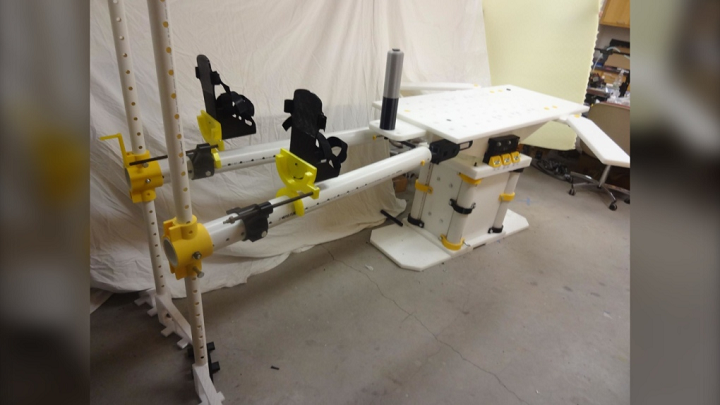We hear a lot about 3D printed medical devices like models, implants, prosthetics, surgical tools, and even medical device packaging, but how about a 3D printed surgical fracture table? Researchers from Western University and Michigan Technological University collaborated on a project to develop the table, which was created for far less money than it would usually cost to build one. The team summarized their findings in a study, which explains how the accessible open source table was built using common hand tools and materials, and a desktop 3D printer.
A surgical fracture table is used to help position a patient during procedures, so additional healthcare workers aren’t needed to hold them in the proper position the whole time. It’s a helpful tool, but a costly one: it’s estimated that the capital cost of a conventional surgical fracture table is upwards of $250,000. This 3D printed table cost less than $4,000 to make, which saves more than 98% in comparison to a commercially available version.
“We want everyone in the world to have cost-effective medical care and this is one step on the path to getting us there. And if we help those who are financially less fortunate with acquiring high-performance medical equipment, we will also be making better medical tools for ourselves at a lower cost, so really, everyone wins,” said open source advocate Joshua Pearce, the John M. Thompson Chair of Information Technology and Innovation at Western.
According to Western, the team’s work on this open source table could be very impactful in developing countries, where universal access to healthcare is low due to many reasons, including the high cost of medical equipment. Additionally, nine priorities laid out by the World Bank for cost-effective surgeries that should be globally available are orthopedic procedures, such as trauma-related amputations, treating fractures, repairing clubfoot deformities, escharotomy/fasciotomy, draining septic arthritis, and more. In addition to many orthopedic procedures, this open source table can also be used by surgeons to complete general surgical procedures, gynecological ones, and for childbirth.
The study’s abstract reads, “With the advent of 3-D printing, a new way to reduce medical equipment costs is to use open source hardware licensed designs to fabricate digitally-distributed manufactured medical hardware. That approach is applied here to make surgical tables more accessible. This study describes the design and manufacture of an open source surgical fracture table that uses materials that are widely available worldwide with specialty components being 3-D printed. The bill of materials and assembly instructions are detailed and the fracture table is validated to perform mechanically to specifications.”
Because the low-cost table is open source—meaning its design is freely available—it can be improved upon for different surgical procedures, and potentially built at an even lower cost, which would be very helpful for hospitals that may not be able to afford this kind of table otherwise. Surgeons and other healthcare workers could make the design of this table even more functional by designing their own modifications, or bringing their idea for a modification to a designer or engineer who can help make it a reality. According to Pearce, everyone can have access to superior medical equipment this way.
“Medical technology is absurdly expensive. One way we can help reduce costs is to enable all manufacturers to build these, sell them directly, and to integrate some of the innovations, like the use of the radiolucent 3D-printed parts we made into their own designs. This is in no way the final fracture table,” Pearce continued. “I’m sure any decent engineer could look at it and make it a little bit better and that’s exactly what it’s meant to do — to be a starting point for other people to build on.”
The modular table in its current form features several components 3D printed out of PETG and TPU on a desktop FFF 3D printer—specifically the LulzBot Taz 6—while other parts were manufactured from high density polyethylene (HDPE) sheets. It’s mechanically adjustable, so electricity is not required, and the table also has a weight capacity of over 130 kg (286 lbs), geometric flexibility for multiple common surgeries, and is radiolucent in surgical zones, meaning it’s permeable to X-rays.
“Using an open source desktop RepRap-class 3-D printer, the components can be printed in a little over a week of continuous printing. Including the 3-D printed parts, the open source fracture table can be constructed for under US$3,000 in material costs, representing a 98.5% savings for commercial systems, radically increasing accessibility. The open source table can be adjusted 90–116 cm in height, tilted from +/-15 degrees, the leg height ranges from 31 to 117 cm, the arm supports and foot holder both have a 180-degree range, the foot position has a 54 cm range, and the legs can be adjusted from 55 to 120 degrees,” the researchers wrote.
According to Pearce, we’re at the beginning of “a decentralized manufacturing revolution,” where designs can be digitally shared and replicated using technologies like 3D printing.
“As of now, most things that you have around your house, from toys to kitchen gadgets, already have CAD (computer aided design) models freely available for you to download and replicate with the right tools,” he continued. “You can make the economic case to 3D print your own toys and gadgets, but this study takes it up several notches, to provide a path to high-value medical tools.”
